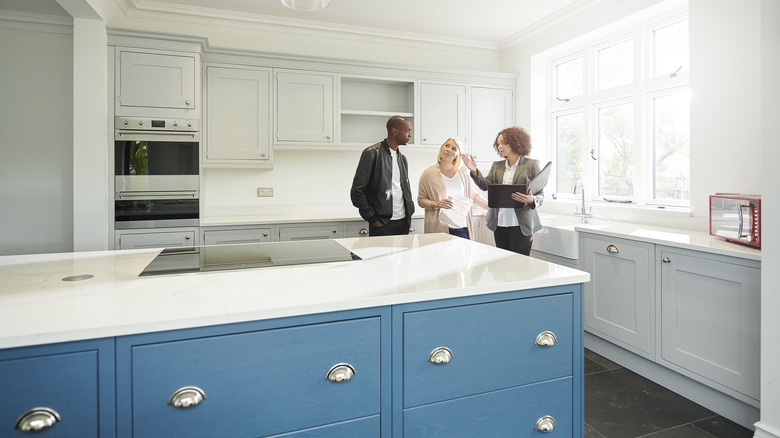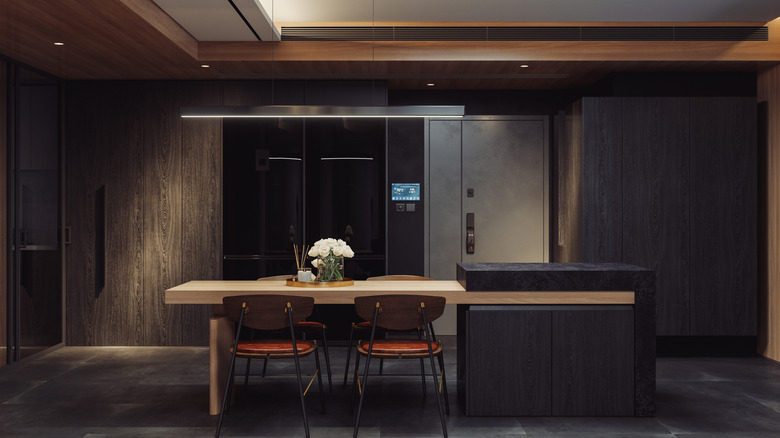Kitchen Cabinet Choices That Will Make It Harder To Sell Your Home
It is common knowledge among real estate professionals that a kitchen has a significant impact on the sellability of a house. In fact, according to a survey by Rocket Homes, more than half of potential buyers (55%) will choose to purchase a property with a good-quality kitchen even if the rest of the house does not necessarily hit all of the marks. Along with a few other features, the respondents specified kitchen cabinets as one of the most important elements influencing their decision.
Whether you're planning to sell your house in the very distant future or renovating it in preparation for hitting the market soon, you should give serious consideration to the kitchen cabinets and drawers. Investing without a resale mindset can end up in costly upgrades and replacements or worse: renovations that fail to add resale value. Thankfully, real estate experts and designers can tell us the pitfalls to steer clear of. These are the types of kitchen cabinets to avoid and save your house from collecting dust on the property market.
Cabinets made from particle board
The type of material is one of the determining factors of a cabinet's durability. If your kitchen cabinets happen to be made of particle board, they may turn buyers off. This engineered wood product is made of recycled wood particles pressed and sandwiched together using an adhesive resin. While they are notably cheaper compared to higher-quality materials, they also have lower resistance to moisture, impacts, and scratches. Their surface can also be difficult to re-finish. This means solving even minor damage could require refacing them.
All these issues make particle boards a disadvantageous choice for long-term investment and many property experts know it quite well. On her blog, Ariel Path, a professional kitchen designer, says "Particle board cabinets have lower resale value than plywood kitchen cabinets and solid wood cabinets." So, if you wish to resell your home, make the smart choice with one of these more appealing materials.
Choosing intense colors
If you like being bold and daring, you might be tempted to coat your cabinets in colors that pop and stand out. According to most professionals, that is one of the easiest ways to deter a buyer. Intense colors are a niche style that only a select number of people would appreciate. And even if your client is among them, there is a narrow chance that your choice of color is the same as theirs. Red-toned kitchens, for instance, can shrink your property's selling price by an average of $2,310 based on a study published by Zillow.
So what are the best color choices for kitchen cabinets? Experts say go for neutrals such as white, grey, olive, and wood tones. These timeless hues never go out of fashion and don't overwhelm the eye. Tuxedo kitchen cabinets, where the bottom ones are a dark hue and the top ones are light, are also a popular look. In fact, Zillow shares that this specific style can boost a house's price by about $1,500 above the expected amount.
Unused space between the cabinet and ceiling
In a room where every corner has a function to serve, wasting space in a kitchen is a big mistake. And, one notorious eyesore to buyers is the gap between the ceiling and the cabinetry. "Nobody wants to think about the space above their cabinets. They want that space closed off one way or another," says Vanessa Horwat, a design consultant for Deslaurier Custom Cabinets. Not only is it a waste of potential storage but also a perfect habitat for dust and cobwebs. Anticipating the cost and work needed to cover this gap is a big letdown and can cost a potential sale.
If you are replacing your cabinets, make sure the new ones go all the way up to the ceiling. However, if the room is already designed with a space, there are clever ways to solve it. You can fill the gap above the cabinets by creating a faux bulkhead or decorating with crown molding for a custom look.
Double stacked cabinets
Horwat also discourages using double-stacked cabinets. As the name suggests, double-stacked or two-tiered cabinets are overhead cabinets with two layers, one on top of the other. The experienced designer notes that this type of layout is opted for decorative purposes rather than functionality. The upper layer is difficult to reach due to its height. Therefore, it is mostly just used for displaying items that people rarely need. This lack of practical use does not justify the high cost of constructing such a sophisticated fixture. Safety is also an issue due to the risk of falling or dropping something while trying to access it.
Though it might appeal to some people, you may want to reconsider opting for this cabinetry design. Instead, you can install single cabinets for a seamless look at a lower cost. And if you wish to put some items on display, you can still designate some of the units to have glass doors.
A layout that blocks out all natural lighting
Sunlight brings forth a myriad of benefits to any kitchen. It not only illuminates the room, but it also acts as a natural disinfectant, killing germs on surfaces and preventing the build-up of mold. Moreover, natural lighting reduces your electricity consumption and makes the space feel bigger. Therefore, covering the kitchen walls with cabinets and shelves and leaving no room for windows is not the wisest approach. Patti Stern, owner of PJ & Company Staging and Interior Decorating, writes "A dark room is an immediate turn-off to buyers" (via the Coldwell Banker blog.)
Balancing storage and sunshine is all about the allocation of wall usage. There needs to be a fine ratio between cabinets and windows. If possible, use the interior walls for your cabinetry and shelving while leaving more space on the exterior walls for your windows. If the room is built with limited openings, you can amplify natural lighting by using white shades and reflective surfaces.
The wrong cabinet hardware
One of the most affordable upgrades you can do for your cabinetry is to install new hardware. Relocation Specialist and Real Estate Agent, Jennifer Lebow, describes it as "one of the least expensive, but one of the highest ROI projects you can do." Kyle Kurtenbach, founder of Rous Hardware, also agrees that this strategy certainly increases the value of a home. However, he warns that selecting the right hardware is crucial to making it work. He writes, "The most common mistake people make when placing cabinet hardware is not considering the design of the cabinets and the room. They choose hardware that is too small or too large for the cabinets or place it in the wrong position..."
Before going to the supply store, you should already have an idea of the design you need. There is a vast selection of pulls and knobs out there and it is easy to fall in love with a certain piece though it does not necessarily harmonize with your space. Some of the factors to consider include size, finish, and choosing between modern or traditional styles.
Cabinet layouts with open shelving
Not so long ago, we saw the rise of open shelving as a new kitchen cabinet trend. However, the craze proved to be short-lived. While the ease of access does sound convenient, many people still prefer to keep their storage private. Real estate agents caution against the use of open shelving as well, stating that homeowners question its long-term use and the need for frequent cleaning. Just like double-stack cabinets, coverless shelves also favor aesthetics more than function. As realtor Ellen Sykes explains to Apartment Therapy, "Open shelving gives you less than half of the space that a closed cabinet would give you.".
Again, if you wish to venture into the exposed cabinetry look, it is advisable to do so in moderation. Mix a few open shelves in with covered cabinets to achieve the same vibe. This concept can often work for bigger kitchens with abundant cabinetry that can afford to leave some storage open.
All dark cabinets
Tall and dark is no longer handsome when it comes to kitchen cabinets nowadays. At least, that is what some property experts say. Hailed for their luxurious and dramatic flair, dark-colored cabinets such as navy blue and forest green are now losing popularity due to their negative impact on resale value. Owner and managing broker for Miami's Prestige Realty Group, Tony Rodriguez-Tellaheche, explains it in his interview with Realtor.com saying,"Dark kitchen cabinets with dark granite is a thing of the past and can make a home hard to sell, especially to millennial buyers."
Using light neutral tones is best when choosing a color palette for your kitchen. These classic options have withstood the test of trend-changing times. However, we are not shutting off the lights completely on the shady kitchen look. If you want to go in this direction, dark gray shades might be an exemption. Contrary to the above, Zillow reports that a deep graphite gray kitchen can swell a property's selling price by $2,512.








